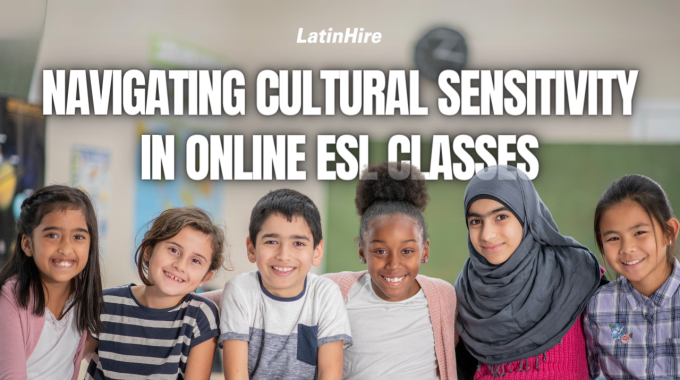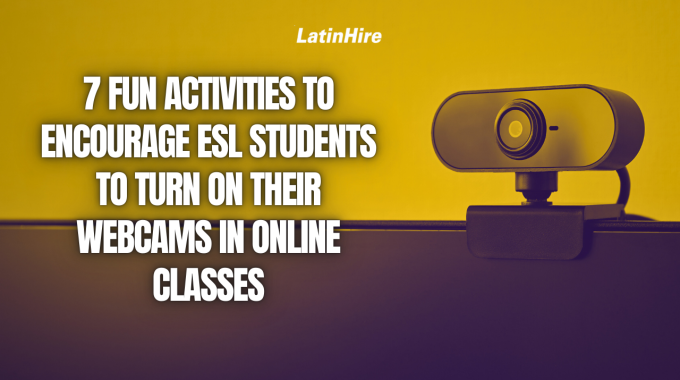As an online ESL teacher, one of the biggest challenges can be getting your students…

Navigating Cultural Sensitivity in Online ESL Classes
In the dynamic world of online ESL teaching, educators often find themselves in virtual classrooms filled with students from diverse cultural backgrounds. Navigating cultural sensitivity is a crucial aspect of creating an inclusive and supportive learning environment for English students all over the world.
Understanding the importance of cultural sensitivity in English classes is essential because language lessons inherently involve significant cultural components. By recognizing the diversity among our students, they can feel safe, heard and seen. It’s not about avoiding misunderstandings across cultures, but rather having open discussions and culturally inclusive activities to educate students on the diversity all around them.
Language learning transcends mere vocabulary and grammar; it’s a mosaic of culture, identity and different world views. As an education, you have the amazing opportunity to nurture and encourage your students to be more accepting of those different from them. By allowing each student’s voice to soar individually, they can work together to create a collective comprehension of various cultures.
In this article, let’s explore strategies and tips for helping online ESL teachers navigate cultural sensitivities in their classes, while fostering understanding and respect across the different cultures among their students.
1) Get to know your students and their individual backgrounds.

In an online ESL class with students from diverse backgrounds, taking the time to understand each student’s unique background is paramount. Ask about their cultural heritage, traditions, and values. This knowledge allows you to tailor your teaching approach to resonate with their experiences, fostering a more meaningful connection.
By knowing more about your students, you can personalize the learning experience and make the lessons more engaging. This also shows your genuine commitment to embracing and respecting the rich tapestry of cultures within your virtual classroom.
2) Establish an inclusive classroom environment.
Creating an inclusive virtual environment is crucial for fostering a sense of belonging among ESL learners from different cultural backgrounds. Establish ground rules that promote respect and open-mindedness, encouraging students to share their unique perspectives without fear of judgment.
Cultivate an atmosphere where every voice is heard and valued. Use inclusive language and promote an attitude of acceptance, ensuring that your classroom is a safe place where diversity is celebrated and cultural differences are embraced rather than overlooked.
3) Use teaching materials that represent various cultures.
To truly engage students from diverse backgrounds, it’s essential to incorporate teaching materials that reflect a wide array of cultures. Selecting diverse and culturally relevant content helps students see themselves in the material, making the learning experience more relatable and meaningful.
Be mindful of cultural sensitivities when choosing images, examples, or scenarios, ensuring they are inclusive and avoid perpetuating stereotypes. A curriculum that reflects the global nature of language fosters a deeper appreciation for different cultures and enriches the overall educational experience.
4) Reflect on biases and stereotypes.

As an ESL teacher navigating cultural sensitivities online, it’s crucial to regularly reflect on your own biases and preconceptions. Acknowledge and challenge any stereotypes that may unconsciously influence your teaching.
Encourage students to share their perspectives, correcting misconceptions, and fostering a more accurate understanding of diverse cultures. This self-awareness is a continuous process that not only enriches your teaching but also sets an example for students, promoting an atmosphere of mutual respect and understanding.
5) Encourage collaborative learning.
Promoting collaborative learning within your online ESL class can break down cultural barriers and encourage students to learn from one another. Implement group projects, discussions, and collaborative activities that require students to work together towards a common goal.
This not only enhances language skills but also provides opportunities for cultural exchange and understanding. Encourage students to share their unique perspectives, fostering a sense of unity and cooperation that transcends cultural differences. Collaborative learning can be a powerful tool for building connections and breaking down cultural barriers in the virtual classroom.
6) Offer cultural sensitivity training for students.
Incorporating cultural sensitivity training into the ESL curriculum is a proactive approach to fostering a respectful and inclusive online learning environment. By providing students with tools to navigate cultural nuances, educators empower them to engage in open-minded and empathetic interactions.
This training not only enhances intercultural communication skills but also encourages students to recognize and challenge their own biases, creating a community that values diversity and fosters mutual respect. By having conversations around cultural sensitivity in the classroom, students can become better global citizens who appreciate and embrace the richness of the diverse world around them.
7) Use technology for cultural exchange.
In the digital age, technology offers unprecedented opportunities for cultural exchange in the online ESLl classroom. Explore virtual exchange programs, video conferencing tools, and collaborative online platforms to connect students with peers from different cultural backgrounds.
These experiences transcend geographical boundaries, providing students with the chance to shape their own cultural perspectives while learning from others. Embracing technology for cultural exchange not only enriches language learning but also cultivates a sense of global interconnectedness, fostering friendships and understanding that extend beyond the virtual classroom.
8) Seek feedback and adapt.

Continuous improvement is key to maintaining a culturally sensitive online ESL class. Encourage open communication by actively seeking feedback from students about their experiences and whether their cultures were accurately represented during class. You can even establish anonymous channels for feedback to ensure honest and constructive input.
Use this feedback as a guide for adapting teaching methods, course content, and communication strategies. An adaptive approach demonstrates a commitment to addressing the evolving needs of a diverse student body, fostering an environment where every student feels heard, valued, and supported on their language learning journey.
9) Celebrate cultural events and holidays.
Infusing the ESL curriculum with celebrations of cultural events and holidays is a powerful way to acknowledge and honor the diverse backgrounds of students. Incorporate themed lessons, activities, or projects that highlight significant cultural events and holidays, allowing students to share their traditions and learn about those of their peers.
Celebrations not only create a positive and inclusive atmosphere but also contribute to a deeper understanding of cultural practices. By embracing and commemorating cultural diversity, the online ESL classroom becomes a space where students feel a sense of belonging and pride in their unique identities.
We hope you enjoyed this article about navigating cultural sensitivities in an online ESL class. What other strategies do you use in your classroom to create a culturally inclusive environment? Share them in the comments below!



